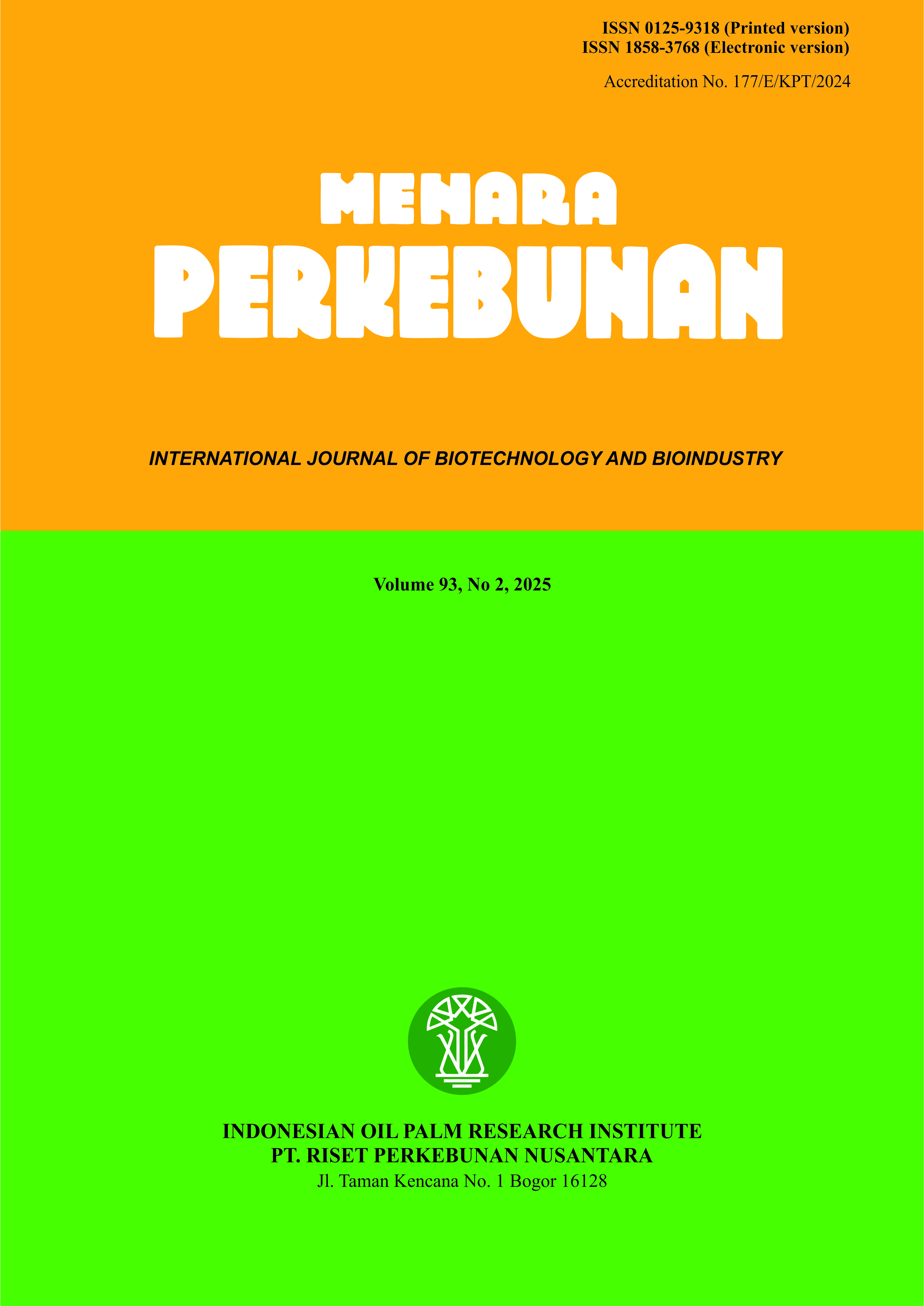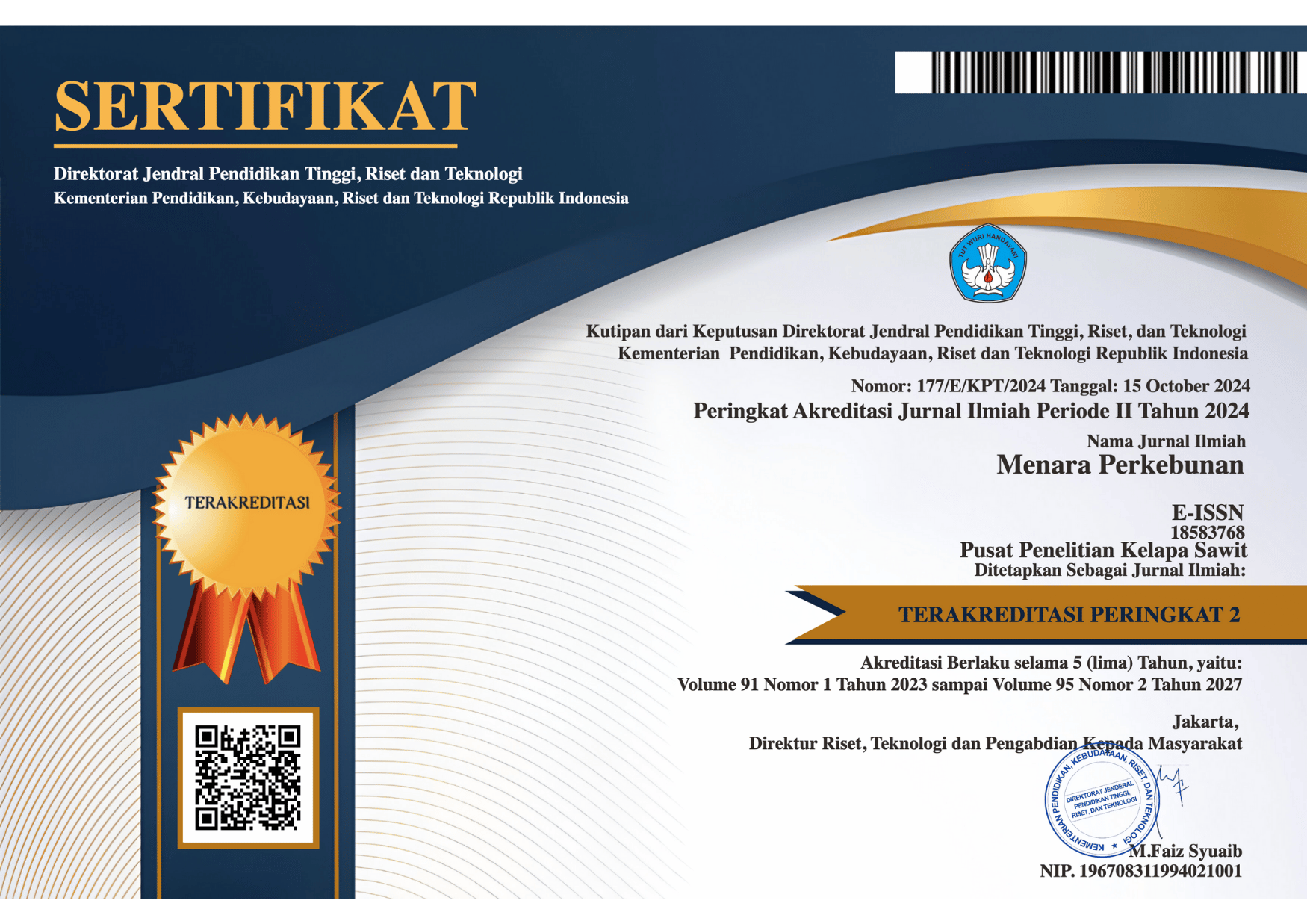In silico study: identification and characterization of heat shock protein 90 (HSP90) in Arabica coffee (Coffea arabica L.)
DOI:
https://doi.org/10.22302/iribb.jur.mp.v93i2.663Keywords:
bioinformatics, biotic and abiotic stress , C3 plant, heat stressAbstract
The use of low-quality planting material and extreme weather conditions caused by global warming are major factors contributing to low Arabica coffee productivity in Indonesia. The development of new cultivars and the improvement of Arabica coffee adaptability play crucial roles in preventing productivity decline. This study aims to identify and characterize HSP90 proteins in Arabica coffee through in silico analysis, focusing on their adaptability to biotic and abiotic stress conditions. This study was conducted using DNA and HSP90 protein sequences from Arabica coffee retrieved from various databases. The analysis included assessments of physicochemical properties, gene structure analysis, protein subcellular localization prediction, cis-acting element analysis, protein interaction analysis, and phylogenetic analysis. The results identified a total of twenty CaHSP90 genes distributed across 11 Arabica coffee chromosomes. Characterization revealed that the HSP90 protein family has diverse physicochemical properties, with varying sequence lengths and molecular weights. Most members are acidic, hydrophilic proteins localized in the cytoplasm. Analysis of the CaHSP90 gene expression based on cis-acting elements and phylogenetics showed that HSP90 in Arabica coffee is expressed in response to biotic and abiotic stresses as well as defense against pathogens. The results of this study provide a foundation for the development of new Arabica coffee cultivars with improved resistance to biotic and abiotic stresses, and support the selection of candidate CaHSP90 genes for breeding programs.
Downloads
References
Albakova, Z. (2024). HSP90 multi-functionality in cancer. Frontiers in Immunology, 15, 1-13. https://doi.org/10.3389/fimmu.2024.1436973
Appiah, C., Yang, Z. F., He, J., Wang, Y., Zhou, J., Xu, W. Z., Nie, G., & Zhu, Y. Q. (2021). Genome-wide identification of the hsp90 gene family in perennial ryegrass and expression analysis under various abiotic stresses. Plants, 10(11). https://doi.org/10.3390/plants10112509
Badan Pusat Statistik. (2023). Statistik Kopi Indonesia. Jakarta: Badan Pusat Statistik.
Bellon, S., Parsons, J. D., Wei, Y., Hayakawa, K., Swenson, L. L., Charifson, P. S., Lippke, J. A., Aldape, R., & Gross, C. H. (2004). Crystal structures of Escherichia coli topoisomerase IV ParE subunit (24 and 43 kilodaltons): a single residue dictates differences in novobiocin potency against topoisomerase IV and DNA gyrase. Antimicrobial Agents and Chemotherapy, 48(5), 1856-1864. https:// doi.org/10.1128/AAC.48.5.1856-1864.2004
Bettaieb, I., Hamdi, J., & Bouktila, D. (2020). Genome-wide analysis of the hsp90 gene family in the Mediterranean olive (Olea europaea subsp. europaea) provides insight into structural patterns, evolution, and functional diversity. Physiology and Molecular Biology of Plants, 26(11), 2301-2318. https://doi.org/10.1007/ s12298-020-00888-x
Chauhan, J., Prathibha, M. D., Singh, P., Choyal, P., Mishra, U. N., Saha, D., Kumar, R., Anuragi, H., Pandey, S., Bose, B., Mehta, B., Dey, P., Dwivedi, K. K., Gupta, N. K., & Singhal, R. K. (2023). Plant photosynthesis under abiotic stresses: Damages, adaptive, and signaling mechanisms. Plant Stress, 10, 1-13. https://doi.org/10.1016/j.stress.2023.100296
Chen, C., Wu, Y., Li, J., Wang, X., Zeng, Z., Xu, J., Liu, Y., Feng, J., Chen, H., He, Y., & Xia, R. (2023). TBtools-II: A “one for all, all for one” bioinformatics platform for biological big-data mining. Molecular Plant, 16(11), 1733-1742. https://doi.org/10.1016/j.molp.2023.09.010
Chiosis, G., Digwal, C. S., Trepel, J. B., & Neckers, L. (2023). Structural and functional complexity of HSP90 in cellular homeostasis and disease. Nature Reviews Molecular Cell Biology, 24(11), 797–815. https://doi.org/10.1038/s41580-023-00640-9
Donato, M. & Geisler, M. (2019). Hsp90 and co-chaperones: a multitaskers’ view on plant hormone biology. FEBS Letters, 593(13), 1415-1430. https://doi.org/10.1002/1873-3468.13499
Gasteiger, E., et al. (2005). Protein Analysis Tools on the ExPASy Server. The Proteomics Protocols Handbook. [Online] Available: https://web.expasy.org/tools/
Goodstein, D. M., Shu, S., Howson, R., Neupane, R., Hayes, R. D., Fazo, J., Mitros, T., Dirks, W., Hellsten, U., Putnam, N., & Rokhsar, D. S. (2012). Phytozome: A comparative platform for green plant genomics. Nucleic Acids Research, 40(D1). https://doi.org/10.1093/nar/gkr944
Horton, P., Park, K. J., Obayashi, T., Fujita, N., Harada, H., Adams-Collier, C. J., & Nakai, K. (2007). WoLF PSORT: Protein localization predictor. Nucleic Acids Research, 35, W585-W587. https://doi.org/10.1093/nar/gkm259
Hu, B., Jin, J., Guo, A. Y., Zhang, H., Luo, J., & Gao, G. (2015). GSDS 2.0: An upgraded gene feature visualization server. Bioinformatics, 31(8), 1296-1297. https://doi.org/10.1093/bioinforma tics/btu817
Hu, S., Ding, Y., & Zhu, C. (2020). Sensitivity and responses of chloroplasts to heat stress in plants. Frontiers in Plant Science, 11, 1-11. https://doi.org/10.3389/fpls.2020.00375
Hu, W., Hu, G., & Han, B. (2009). Genome-wide survey and expression profiling of heat shock proteins and heat shock factors revealed overlapped and stress specific response under abiotic stresses in rice. Plant Science, 176(4), 583–590. https://doi.org/10.1016/j.plantsci.200 9.01.016
Immormino, R. M., Dollins, D. E., Shaffer, P. L., Soldano, K. L., Walker, M. A., & Gewirth, D. T. (2004). Ligand-induced conformational shift in the N-terminal domain of GRP94, an Hsp90 chaperone. Journal of Biological Chemistry, 279(44), 46162-46171. https://doi.org/10.1074/ jbc.M405253200
Krishna, P., & Gloor, G. (2001). The Hsp90 family of proteins in Arabidopsis thaliana. Cell Stress & Chaperones, 6(3), 238-246.
Lescot, M., Déhais, P., Thijs, G., Marchal, K., Moreau, Y., Van De Peer, Y., Rouzé, P., & Rombauts, S. (2002). PlantCARE, a database of plant cis-acting regulatory elements and a portal to tools for in silico analysis of promoter sequences. Nucleic Acids Research. http://sphinx.rug.ac.be:8080/PlantCARE/
Liu, C., Yu, H., Rao, X., Li, L., & Dixon, R. A. (2021). Abscisic acid regulates secondary cell-wall formation and lignin deposition in Arabidopsis thaliana through phosphorylation of NST1. PNAS, 118(5), 1-11. https://doi.org/ 10.1073/pnas.2010911118
Liu, Y., Wan, H., Yang, Y., Wei, Y., Li, Z., Ye, Q., Wang, R., Ruan, M., Yao, Z., & Zhou, G. (2014). Genome-wide identification and analysis of heat shock protein 90 in tomato. Yi Chuan = Hereditas / Zhongguo Yi Chuan Xue Hui Bian Ji, 36(10), 1043-1052. https://doi.org/10.3724/ SP.J.1005.2014.1043
Luo, A., Li, X., Zhang, X., Zhan, H., Du, H., Zhang, Y., & Peng, X. (2019). Identification of AtHsp90.6 involved in early embryogenesis and its structure prediction by molecular dynamics simulations. Royal Society Open Science, 6(5). https://doi.org/10.1098/rsos.190219
Magnard, J. L., Vergne, P., & Dumas, C. (1996). Complexity and genetic variability of Heat-Shock protein expression in isolated maize microspores. Plant Physiology, 111(4), 1085–1096. https://doi.org/10.1104/pp.111.4.1085
Mondol, T., Silbermann, L. M., Schimpf, J., Vollmar, L., Hermann, B., Tych, K. (Kasia), & Hugel, T. (2023). Aha1 regulates Hsp90’s conformation and function in a stoichiometry-dependent way. Biophysical Journal, 122(17), 3458–3468. https://doi.org/10.1016/j.bpj.2023. 07.020
Muthusamy, M., Son, S., Park, S. R., & Lee, S. I. (2023). Heat shock factor binding protein BrHSBP1 regulates seed and pod development in Brassica rapa. Frontiers in Plant Science, 14. https://doi.org/10.3389/fpls.2023.1232736
Niikura, Y., & Kitagawa, K. (2019). Functions of SGT1, a Co-chaperone, 317–370. https:// doi.org/10.1007/978-3-030-23158-3_16
Oldroyd, G. E. D., & Leyser, O. (2020). A plant’s diet, surviving in a variable nutrient environment. Science, 368. https://doi.org/ 10.1126/science.aba0196
Peng, J., Liu, S., Wu, J., Liu, T., Liu, B., Xiong, Y., Zhao, J., You, M., Lei, X., & Ma, X. (2024). Genome-wide analysis of the oat (Avena sativa) hsp90 gene family reveals its identification, evolution, and response to abiotic stress. International Journal of Molecular Sciences, 25(4). https://doi.org/10.3390/ijms25042305
Sajad, S., Jiang, S., Anwar, M., Dai, Q., Luo, Y., Hassan, M. A., Tetteh, C., & Song, J. (2022). Genome-wide study of the hsp90 gene family in cabbage (Brassica oleracea var. capitata L.) and their imperative roles in response to cold stress. Frontiers in Plant Science, 13. 1-13. https://doi.org/10.3389/fpls.2022.908511
Sarkar, N. K., Kim, Y. K., & Grover, A. (2009). Rice sHsp genes: genomic organization and expression profiling under stress and development. BMC Genomics, 10(393), 1-18. https://doi.org/10.1186/1471-2164-10-393
Savinkova, L. K., Sharypova, E. B., & Kolchanov, N. A. (2023). On the role of TATA boxes and TATA-Binding protein in Arabidopsis thaliana. Plants 12(5). https://doi.org/10.3390/plants 12051000
Schopf, F. H., Biebl, M. M., & Buchner, J. (2017). The HSP90 chaperone machinery. Nature Reviews Molecular Cell Biology, 18(6), 345–360. https://doi.org/10.1038/nrm.2017.20
Song, H., Fan, P., & Li, Y. (2009). Overexpression of organellar and cytosolic atHSP90 in Arabidopsis thaliana impairs plant tolerance to oxidative stress. Plant Molecular Biology Reporter, 27(3), 342–349. https://doi.org/ 10.1007/s11105-009-0091-6
Song, Z., Pan, F., Yang, C., Jia, H., Jiang, H., He, F., Li, N., Lu, X., & Zhang, H. (2019). Genome-wide identification and expression analysis of HSP90 gene family in Nicotiana tabacum. BMC Genetics, 20(1). https://doi.org/10.1186/s12863-019-0738-8
Szklarczyk, D., Gable, A. L., Lyon, D., Junge, A., Wyder, S., Huerta-Cepas, J., Simonovic, M., Doncheva, N. T., Morris, J. H., Bork, P., Jensen, L. J., & Von Mering, C. (2019). STRING v11: Protein-protein association networks with increased coverage, supporting functional discovery in genome-wide experimental datasets. Nucleic Acids Research, 47(D1), D607–D613. https://doi.org/10.1093/nar/gky 1131
Tamura, K., Stecher, G., & Kumar, S. (2021). MEGA11: molecular evolutionary genetics analysis version 11. Molecular Biology and Evolution, 38(7), 3022-3027. https://doi.org/ 10.1093/molbev/msab120.
Thompson, J. D., Higgins, D. G., & Gibson, T. J. (1994). CLUSTAL W: improving the sensitivity of progressive multiple sequence alignment through sequence weighting, position-specific gap penalties and weight matrix choice. Nucleic Acids Research, 22(22), 4673-4680.
Tigchelaar, M., Battisti, D. S., Naylor, R. L., & Ray, D. K. (2018). Future warming increases probability of globally synchronized maize production shocks. Proceedings of the National Academy of Sciences of the United States of America, 115(26), 6644–6649. https://doi.org/ 10.1073/pnas.1718031115
Wang, L., Liu, F., Ju, L., Xue, B., Wang, Y., Wang, D., & Hou, D. (2022). Genome structures and evolution analysis of the hsp90 gene family in Brassica napus reveal the possible roles of members in response to salt stress and the infection of Sclerotinia sclerotiorum. Frontiers in Plant Science, 13. https://doi.org/10.3389/ fpls.2022.854034
Wasilah, U., Perwitasari, D. A. G., & Su’udi, M. (2019). Peran chaperone pada tumbuhan: mini review. JURNAL BIOLOGI PAPUA, 11(2), 110–115. https://doi.org/10.31957/jbp.880
Xue, P., Sun, Y., Hu, D., Zhang, J., & Wan, X. (2023). Genome-wide characterization of DcHsp90 gene family in carnation (Dianthus caryophyllus L.) and functional analysis of DcHsp90-6 in heat tolerance. Protoplasma, 260(3), 807–819. https://doi.org/10.1007/ s00709-022-01815-5
Yu, C., Lin, C., & Hwang, J. (2004). Predicting subcellular localization of proteins for gram‐negative bacteria by support vector machines based on peptide compositions. Protein Science, https://doi.org/10.1110/ps.03479604
Yu, C. S., Chen, Y. C., Lu, C. H., & Hwang, J. K. (2006). Prediction of protein subcellular localization. Proteins: Structure, Function and Genetics, 64(3), 643–651. https://doi.org/ 10.1002/prot.21018
Zai, W. S., Miao, L. X., Xiong, Z. L., Zhang, H. L., Ma, Y. R., Li, Y. L., Chen, Y. B., & Ye, S. G. (2015). Comprehensive identification and expression analysis of Hsp90s gene family in Solanum lycopersicum. Genetics and Molecular Research, 14(3), 7811–7820. https://doi.org/ 10.4238/2015.July.14.7
Zhang, K., He, S., Sui, Y., Gao, Q., Jia, S., Lu, X., & Jia, L. (2021). Genome-wide characterization of HSP90 gene family in cucumber and their potential roles in response to abiotic and biotic stresses. Frontiers in Genetics, 12. https://doi.org/10.3389/fgene.2021.584886
Zhang, M., Shen, Z., Meng, G., Lu, Y., & Wang, Y. (2017). Genome-wide analysis of the Brachypodium distachyon (L.) P. Beauv. Hsp90 gene family reveals molecular evolution and expression profiling under drought and salt stresses. PLoS ONE, 12(12). https://doi.org/ 10.1371/journal.pone.0189187
Downloads
Submitted
Accepted
Published
How to Cite
Issue
Section
License
Copyright (c) 2025 Mukhamad Su'udi, Qori’atul Mustafidah

This work is licensed under a Creative Commons Attribution 4.0 International License.
Authors retain copyright and grant the journal right of first publication with the work simultaneously licensed under a Creative Commons Attribution License that allows others to share the work with an acknowledgement of the work's authorship and initial publication in this journal.













